|
BULB LOG 47 - 23rd November 2005
For many years I have wondered what lay under our garden. I knew that the upper layer was around 1 metre of light, sandy, top soil but this week my curiosity had to be satisfied so I asked Maggi to go out and dig a 3.5 metre deep pit so that I could see the section of the ground.

Ground section
Unfortunately Maggi never likes to do jobs by half and got a bit carried away but it does show clearly the underlying layers. Under the top soil is a deeper layer of heavy clay mixed through with broken stones and this lies on top of a granite. In many ways this is an ideal structure for the plants that we like to grow. The upper layer is light and very free draining while the layer of clay helps to hold nutrients and moisture in times of drought, the granite base gives our soil a slightly acid ph.
For many years we have added a deep layer of humus onto the garden with an annual mulch from our compost heaps. This has given us a 25 to 30 cm layer of well drained humus rich soil ideal for growing bulbs like Trillium and Erythronium.
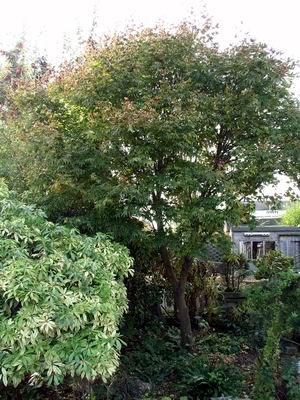
Seed grown Acer
While most of the trees have lost their leaves the Acers that I have raised from seed still hang on to theirs. I have always said when you raise plants from seed you don't select them, they select you. Yes, you initially select the seed to sow but in the course of the first few years some of the seedlings will perish because they cannot adapt to our conditions - both our cultivation and climate - the survivors that reach maturity should grow well for us. Plants that we buy in may have been raised in very different conditions to ours and may not be able to adapt - this is why I always raise plants from seed whenever I can.

Natures free gift
The leaves that have fallen are one of nature's free gifts to gardeners. These should be gathered and made into a nice heap which will in 6 to 9 months provide you with a beautiful leaf mould that you can either spread as a mulch or use as the humus element in your potting mix.
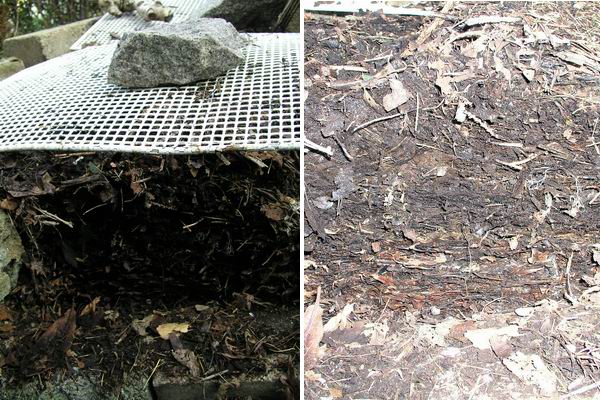
Leafmould
It is worth reminding you how I make my leaf mould heap. Firstly I always make it either in the same place or if I have not used up all of last years pile, then right beside it. The reason for this is that the organisms that aid the break down process will be concentrated in that area. A heap of around 1m square is contained by some old concrete blocks and wire mesh and I always have a bit of rigid wire mesh weighed down by a stone to keep the leaves compact while allowing moisture to penetrate. The leaves should always be moist for best results. I am not a believer in the commonly described method of making leaf mould by placing them in black polythene bags, with or without holes poked in them. I have seen this method shown so many times on TV and in magazines, always with pictures of the leaves being put into the bags - what I have yet to see is any one showing a good rich leaf mould coming back out of one of these bags, I just do not believe it. The results that I have seen are either a bag of dry leaves,
much like they were when the were put in, or a soggy mass of foul smelling leaves, neither of which is much use.
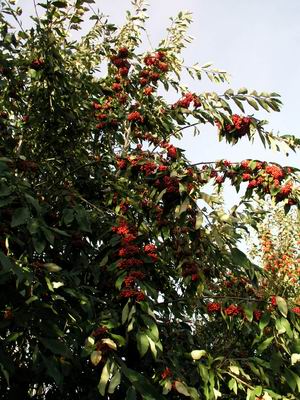
Cotoneaster leaves
We also have lots of Cotoneaster trees that retain their leaves until spring arrives, unless the temperatures drop well below freezing, then they quickly drop them. We have been warned that we are in for a very cold winter so the berries will help feed the birds. The migratory Redwings, Fieldfares and Waxwings are already in the Aberdeen area.
Again there has been some very interesting discussion in the bulb log feedback concerning whether bulbs that get buried too deep, perhaps when the level of a bed is raised, can make their way back closer to the surface. It would not surprise me; bulbs are extremely adept at surviving and as many can take themselves deeper into the soil why would they not be able to cope with suddenly finding themselves deeper - in nature this could be caused by landslips or sediment left after flooding. Most bulbs can grow stems way out of proportion with their scale. Anyone who has grown hyacinths or paper white narcissus indoors for winter flowering decoration will know how these plants can etiolate very rapidly in the warm low light conditions found in our homes. I know that we have galanthus and scilla bulbs that have flowered from well below ground after we raised the level by 1metre when we built a raised bed on top of them. Whether the bulbs have made their way up or are just putting on the extra metre of growth, I do
not know.

Bulb pushing up
Large bulbs would find it difficult to push up through the soil as their shape is such that it prevents the bulbs being pushed upwards by the force of the roots pushing down. If you lay large bulbs on a sand bed to root as I did with these paperwhites you will see that the bulbs rise up because there is no weight of soil to hold them down. For these bulbs to rise through the soil they would have to elongate into a torpedo shape like they do when they are taking themselves down when planted too shallow. Or, as is discussed in the feedback, form a new bulb above the old one. I will have to experiment as my curiosity has now taken hold; I feel a bulb being planted at the bottom of a 1 meter length of drain pipe coming on.
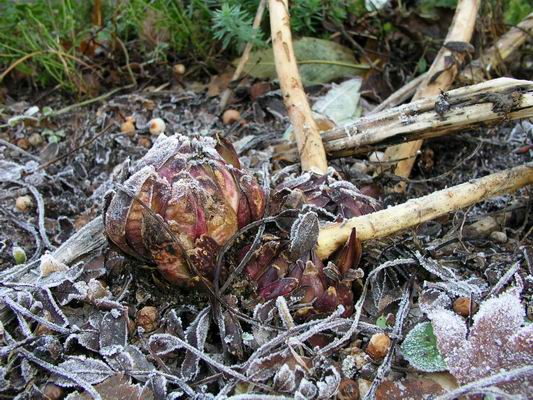
Lily bulb
Some bulbs naturally work their way up to the surface as each new bulb forms above the old one like this lily pictured in today's frosts - I must get around to replanting it. It makes you wonder what happens to these bulbs in the wild. Do they behave differently in their native habitat; do they get an annual heavy mulch of leaves? Some crocus corms also work their way to the surface as each new corm forms on top of the old one and these also need replanted.
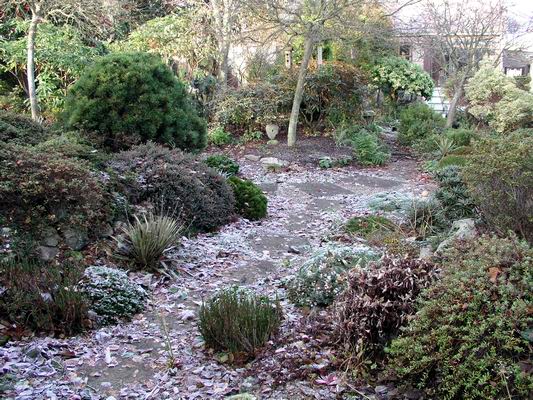
Frost in garden
The hard frosts reminded me to check out the soil warming cables in our glasshouses plunges are all working. I turn the thermostat up until the light comes on and then look for the cable to see that it is warming, then I reset the thermostat to just below 0C.
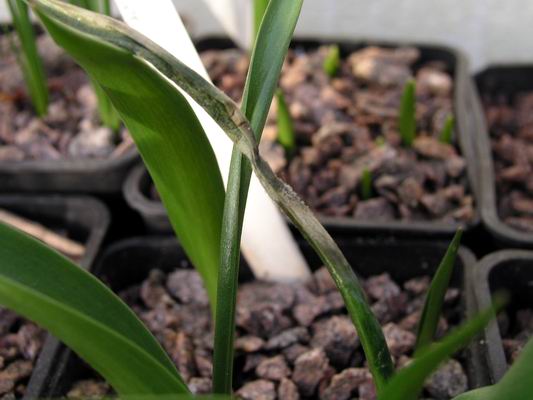
Tulip leave with frost damage
While these cables prevent the bulb and the roots from freezing they have no noticeable effect on the air temperature of the glasshouses which can get very cold. I noticed that one of our Tulips leaves shows signs of damage which I suspect is caused by the frost. Now botrytis is getting a hold of the damaged leaf I will carefully remove it to prevent the mould attacking the rest of the plant.

Digger in pit
OK: I own up, it was not Maggi who dug the pit. A neighbour is having a new basement built and excavating a 3.5 meter deep hole which I just had to go and play in for a while.
^ back to the top ^
|

